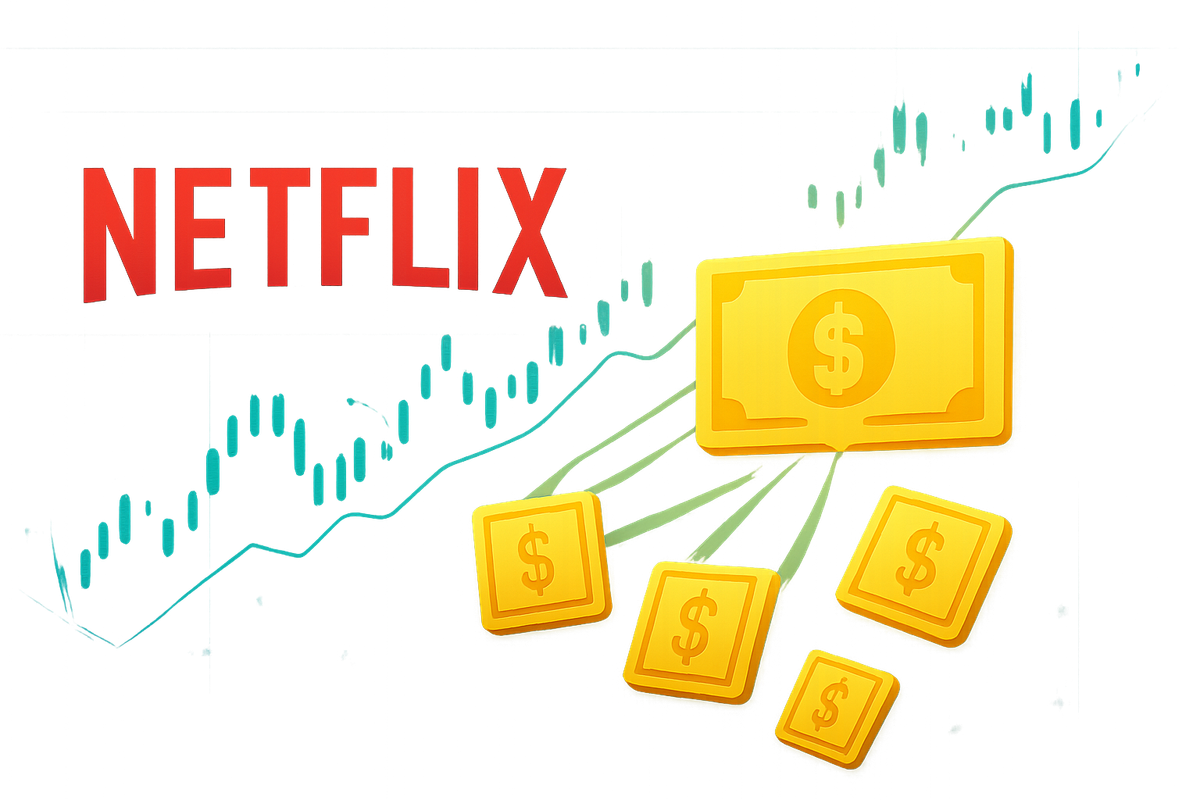
Netflix (NASDAQ: NFLX), the streaming giant, is poised to join the ranks of major technology companies opting for a stock split, with a significant 10-for-1 split scheduled to take effect in mid-November 2025. This highly anticipated move, announced on October 30, 2025, will dramatically increase the number of Netflix shares outstanding while proportionally reducing the price per share. While a stock split does not alter the fundamental value of a company, it often signals management's confidence in future growth and aims to make shares more accessible to a broader base of investors.
This upcoming split marks the third in Netflix's history, following previous splits in 2004 and 2015, and comes at a time when the company continues to navigate a competitive streaming landscape while focusing on profitability and subscriber growth. The decision is expected to generate renewed buzz around the stock, potentially enhancing liquidity and attracting retail investors who may have previously found the per-share price prohibitive.
The Mechanics of Netflix's Latest Stock Split
Netflix's board of directors approved a 10-for-1 forward stock split, a move that will see shareholders receive nine additional shares for every share they hold. The record date for eligible shareholders is set for the close of trading on Monday, November 10, 2025. Following this, the additional shares will be distributed after the close of trading on Friday, November 14, 2025. Trading on a split-adjusted basis is slated to commence at market open on Monday, November 17, 2025.
This strategic maneuver follows a period of robust performance for Netflix, with its stock price experiencing substantial appreciation over the past decade. The high per-share price, while a testament to its success, can sometimes deter smaller individual investors. By reducing the price, Netflix aims to broaden its appeal. While the immediate market reaction has been largely positive, reflecting investor anticipation, the true impact on trading volume and investor demographics will become clearer once the split takes effect. Key stakeholders, including institutional investors and analysts, are closely watching how this change might influence the stock's perception and liquidity.
Understanding the Investor Impact: What a Stock Split Means
For existing investors, a stock split does not change the total value of their holdings. If an investor owns one share of Netflix (NASDAQ: NFLX) at, for example, $700, after a 10-for-1 split, they will own ten shares, each valued at approximately $70. The overall value of their investment remains $700, assuming no other market movements. The primary benefit for individual investors often lies in the psychological effect of a lower share price, making it appear more "affordable" and potentially encouraging greater retail participation. This increased accessibility can lead to higher trading volumes and improved liquidity, making it easier for investors to buy and sell shares.
Historically, companies often execute stock splits when their share price has grown significantly, indicating strong business performance. This move by Netflix could be interpreted as a vote of confidence from management in the company's sustained growth trajectory. While the direct financial impact on public companies like Netflix is minimal in terms of market capitalization, the enhanced liquidity and broader investor base can indirectly benefit the company by maintaining investor interest and potentially supporting a higher valuation over the long term. Other streaming companies or high-growth tech firms with similarly high share prices might observe Netflix's experience and consider similar actions if their stock performance warrants it.
Wider Significance and Historical Context
Netflix's 10-for-1 stock split fits into a broader trend observed among successful, high-growth technology companies. In recent years, giants like Apple (NASDAQ: AAPL), Tesla (NASDAQ: TSLA), Amazon (NASDAQ: AMZN), and Google's parent company, Alphabet (NASDAQ: GOOGL), have all executed stock splits. These companies, much like Netflix, saw their stock prices soar, making individual shares quite expensive. The primary rationale behind these splits has consistently been to make shares more accessible to a wider range of investors, particularly retail investors, and to enhance liquidity.
This move by Netflix could have ripple effects across the streaming and entertainment industry. While direct competitors like Disney (NYSE: DIS) and Warner Bros. Discovery (NASDAQ: WBD) operate with different market dynamics and share prices, the increased retail interest in Netflix post-split might prompt a re-evaluation of investor engagement strategies across the sector. From a regulatory standpoint, stock splits are generally seen as a corporate action with minimal direct regulatory implications, as they do not alter the company's fundamental ownership structure or market capitalization. However, the increased trading activity might draw more attention from market surveillance bodies. Historically, stock splits have often been followed by periods of increased stock price volatility, both upwards and downwards, as the market adjusts to the new price point and increased share count.
What Comes Next for Netflix and Its Investors
In the short term, Netflix's stock (NASDAQ: NFLX) is likely to experience increased trading volume and potentially some price volatility as the market adjusts to the new, lower per-share price. The immediate days and weeks following November 17, 2025, will be crucial in observing how retail investors react to the more accessible share price. For Netflix, this split could translate into a broader and more diverse shareholder base, potentially fostering greater long-term stability and investor loyalty. The company will continue its strategic focus on content creation, international expansion, and exploring new revenue streams, such as advertising-supported tiers and gaming, which are paramount to its sustained growth.
Looking further ahead, the stock split could enable Netflix to be more easily included in certain equity indices or investment vehicles that have per-share price constraints, although this is less common for major indices like the S&P 500. The long-term impact on the stock's valuation will ultimately depend on Netflix's operational performance, subscriber growth, and profitability in a fiercely competitive market. While the split itself is a mechanical adjustment, it sets the stage for a period where Netflix might be perceived differently by a segment of the investment community, potentially influencing its strategic adaptations in capital allocation and investor relations.
A New Chapter for Netflix's Stock
Netflix's impending 10-for-1 stock split marks a significant, albeit largely mechanical, event in the company's financial timeline. The core takeaway for investors is that while their total investment value remains unchanged, the increased number of shares at a lower price point aims to enhance accessibility and liquidity. This move aligns Netflix with a trend among other tech giants who have used splits to broaden their investor base and sustain market interest.
Moving forward, investors should watch for changes in trading volume and the demographic of Netflix's shareholder base. While the split itself is not a fundamental catalyst, it could indirectly influence market sentiment and the stock's trajectory by attracting new retail money. The company's continued execution on its strategic initiatives—content quality, subscriber retention, and global expansion—will remain the ultimate drivers of its long-term value. This split represents a new chapter for Netflix's stock, potentially paving the way for wider ownership and continued market prominence in the ever-evolving streaming landscape.
This content is intended for informational purposes only and is not financial advice





